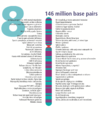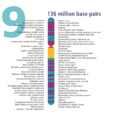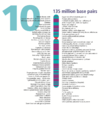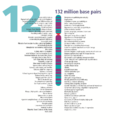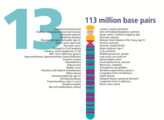Nuclear DNA
Nuclear DNA (nDNA), or nuclear deoxyribonucleic acid, is the
Structure
Nuclear DNA is a
Differences to mitochondrial DNA
Nuclear DNA and
Forensics
Nuclear DNA is known as the molecule of life and contains the genetic instructions for the development of all eukaryotic organisms. It is found in almost every cell in the human body, with exceptions such as red blood cells. Everyone has a unique genetic blueprint, even identical twins.[7] Forensic departments such as the Bureau of Criminal Apprehension (BCA) and Federal Bureau of Investigation (FBI) are able to use techniques involving nuclear DNA to compare samples in a case. Techniques used include polymerase chain reaction (PCR), which allows one to utilize very small amounts of DNA by making copies of targeted regions on the molecule, also known as short tandem repeats (STRs).[8][9]
Cell division
Like
Meiosis creates new combinations of genetic material in each of the four daughter cells. These new combinations result from the exchange of DNA between paired chromosomes. Such an exchange means that the gametes produced through meiosis often exhibit considerable genetic variation.
Meiosis involves two rounds of nuclear division, not just one. Prior to undergoing meiosis, a cell goes through an interphase period in which it grows, replicates its chromosomes, and checks all of its systems to ensure that it is ready to divide.
Like mitosis, meiosis also has distinct stages called prophase, metaphase, anaphase, and telophase. A key difference, however, is that during meiosis, each of these phases occurs twice — once during the first round of division, called meiosis I, and again during the second round of division, called meiosis II.[10]
Replication
Prior to cell division, the DNA material in the original cell must be duplicated so that after cell division, each new cell contains the full amount of DNA material. The process of DNA duplication is usually called
DNA replication begins at a specific site in the DNA molecule called the
DNA damage and repair
Mutation
Nuclear DNA is subject to mutation. A major cause of mutation is inaccurate DNA replication, often by specialized DNA polymerases that synthesize past DNA damages in the template strand (error-prone trans-lesion synthesis).[16] Mutations also arise by inaccurate DNA repair. The microhomology-mediated end joining pathway for repair of double-strand breaks is particularly prone to mutation.[17] Mutations arising in the nuclear DNA of the germline are most often neutral or adaptively disadvantageous. However, the small proportion of mutations that prove to be advantageous provide the genetic variation upon which natural selection operates to generate new adaptations.
Gallery
- The human nuclear DNA displayed into chromosome ideograms with label from Human Genome Project (1990-2003)
See also
References
- ^ "DNA" – via The Free Dictionary.
- ^ "* Nuclear genome (Biology) - Definition, meaning - Online Encyclopedia". en.mimi.hu.
- ^ "Nuclear DNA". thefreedictionary.com.
- ^ "DNA: The Genetic Material". highered.mcgraw-hill.com. Archived from the original on 2020-11-09. Retrieved 2013-03-19.
- S2CID 4355527.
- ^ "Mitochondrial DNA". Archived from the original on 2014-02-01. Retrieved 2014-04-23.
- ^ Casselman, Anne. "Identical Twins' Genes Are Not Identical". Scientific American. Retrieved 18 January 2014.
- ^ "Forensic Science - Nuclear DNA". dps.mn.gov.
- ^ "FBI — Nuclear-DNA Unit". Archived from the original on 2014-07-01. Retrieved 2016-07-28.
- ^ "Replication and Distribution of DNA during Meiosis | Learn Science at Scitable".
- ^ "DNA Replication". Archived from the original on 2013-01-28. Retrieved 2013-04-02.
- ^ "DNA Replication". highered.mcgraw-hill.com.
- PMID 21600302.
- PMID 18458001.
- PMID 25033177.
- PMID 19258535.
- PMID 18809224.






